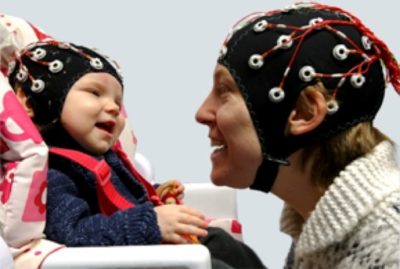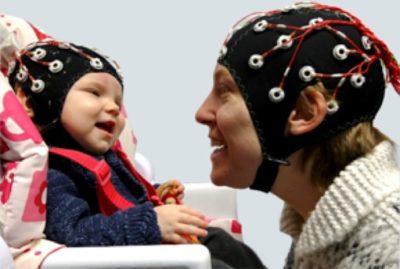 Parents’ brainwaves track and respond to changes in their infant’s brain activity when they play together, according to a recent study published by the research team I’m part of in PLOS Biology [3].
Parents’ brainwaves track and respond to changes in their infant’s brain activity when they play together, according to a recent study published by the research team I’m part of in PLOS Biology [3].
Our team at the UEL Babylab at the University of East London used a novel form of dual EEG called “hyperscanning” in order to gather brainwave data from parents and infants simultaneously. In the course of this experiment, parents and infants were asked to engage in free, tabletop play with toys in two settings. In the first condition (“Joint Play”) the parent and child played together; in the second (“Solo Play”) they played in parallel with two identical sets of toys. The exact times of the infants’ and parents’ looks to and away from the object that they were playing with were also recorded.
In this study, we found reactive increases in parental theta activity (a type of 4 – 7 Hertz brainwave associated with focused attention[1]) that were time-locked to the infant’s attention patterns, while being independent of the parent’s own attention patterns. Furthermore, instances in which parents’ brainwaves tracked their children’s brain waves were associated with longer sustained attention by infants. This suggests that parents are neurally responsive to their infants during social play, and that, when the parent is more neurally responsive, the infant is more attentive.
This dyadic connection was reflected in the babies’ data, as this study also demonstrated that the presence of an adult play partner simultaneously influences the baby’s brainwave patterns. When infants were engaged in Solo Play, the associations were strongest when brain activity at one moment in time was compared to looking behaviour 750ms after that moment. In other words, the infant’s theta brain activity slightly anticipated their looking behaviour. When the baby was engaged in Joint Play with a parent, however, this endogenous (internal) relationship between the infant’s brain activity and their own attention patterns was lower. These results suggest that during Free Play shifts in attention are prompted less by the infants’ own internal thought processes and are more likely prompted by the parent.
This experiment corroborates our lab’s previous findings [2] which suggest that during shared play parents control their infants’ visual attention and sustain it using gaze cues. This supplements the theory that the infants’ own brain activity is less predictive of their visual attention during Joint Play than during Solo Play because parents play a role in supporting or “scaffolding” their social learning in infancy.
This study provides a unique insight into how young infants “learn” social communication. This is important as young infants spend the majority of their lives interacting with caregivers. However, almost everything that we know about how the brain subserves early attention and learning comes from studies that examine brain function in one individual at a time. The “dual” EEG method described here may allow us to answer questions arising from this study; for example, how do we establish and maintain brain synchrony between people? And how and why are some infants and parents more neurally responsive to one another than others?
This project continues two of the University of East London’s proudest research traditions; combining (a) novel data-gathering techniques with (b) high-quality research on the impact of socioeconomic and environmental factors on children’s concentration and learning ability. As the UEL Babylab is situated in one of the most socioeconomically and demographically diverse areas in the UK, we always have a lot of opportunities to undertake this type of research!
For example, the BLAISE (Baby Learning and Infant Sensitivity to the Environment) project looks at the different types of environments that children typically experience at home, and examines how this affects their psychological capabilities. This includes “field-work” by our researchers, who undertake a one-day home visit to deliver specially designed “baby-mounted” recording equipment (baby clothing with a built-in microphone, video camera, and stress monitor) that gather highly detailed environmental data.
Similarly, the Socio-Economic Status, Stress And Selective Attention Project is a neuroimaging project that examines whether children from lower socio-economic status backgrounds tend to show higher levels of physiological stress and lower abilities to “filter out” distracting or distressing information.
Continuing this tradition, our lab has begun piloting the Leverhulme Project, which aims to be an investigation into the role of endogenous attention and eye gaze in brainwave synchrony between parent-child pairs. This experiment will look at the mechanisms of mutual attunement between parents and children and how they affect children’s attention.
This is designed to be the first study to demonstrate an association (on a small, moment-to-moment scale) between infants’ patterns of attentiveness and parents’ attention-related brainwave patterns using the novel “hyper-scanning” technique described above. We look forward to using these innovative techniques to investigate how this type of neural responsiveness by parents may help young children to pay attention to things.
References:
- Klimesch, W., Schack, B., & Sauseng, P. (2005). The functional significance of theta and upper alpha oscillations. Experimental psychology, 52(2), 99-108.
- Wass, S. V., Clackson, K., Georgieva, S. D., Brightman, L., Nutbrown, R., & Leong, V. (2018). Infants’ visual sustained attention is higher during joint play than solo play: is this due to increased endogenous attention control or exogenous stimulus capture?. Developmental science, 21(6), e12667.
- Wass, S. V., Noreika, V., Georgieva, S., Clackson, K., Brightman, L., Nutbrown, R., … & Leong, V. (2018). Parental neural responsivity to infants’ visual attention: how mature brains influence immature brains during social interaction. PLoS biology, 16(12), e2006328.



